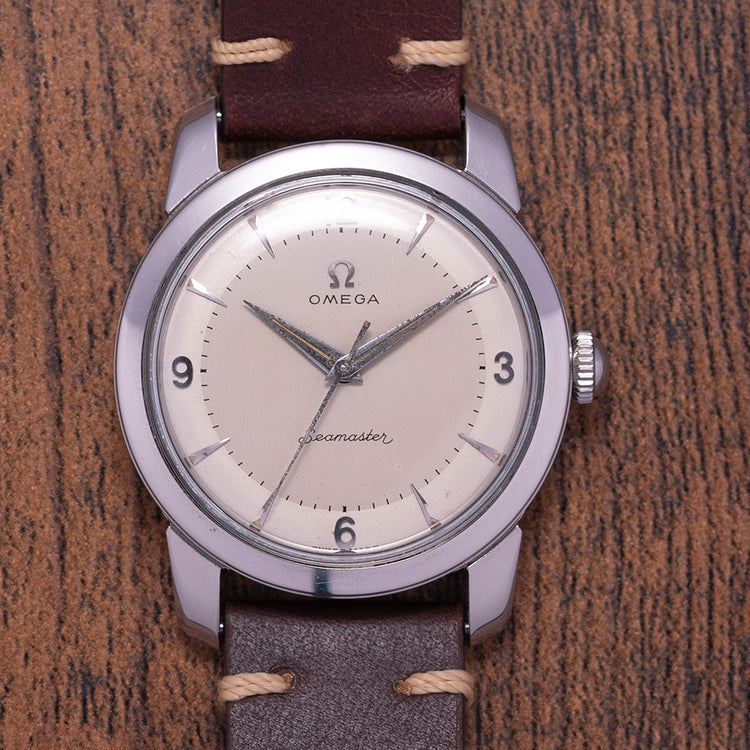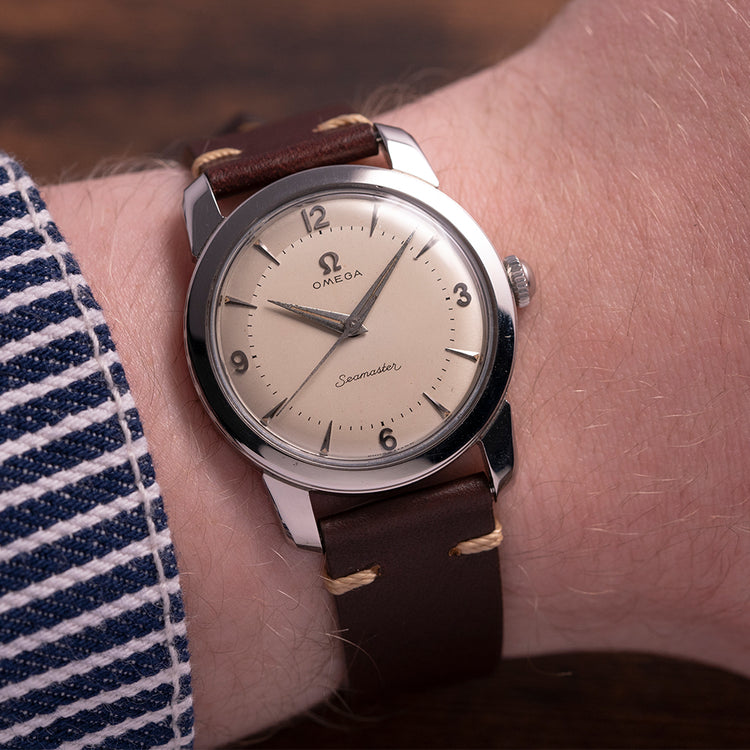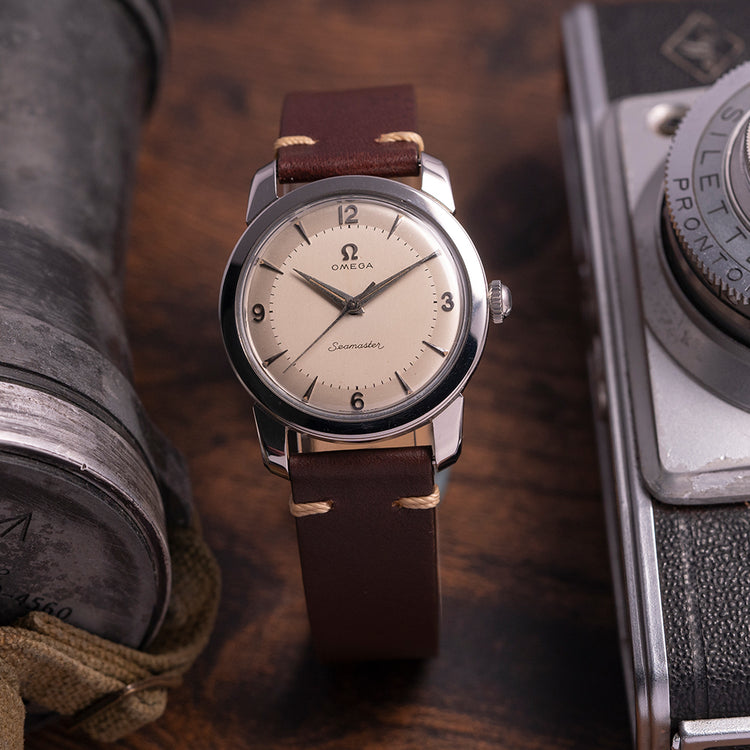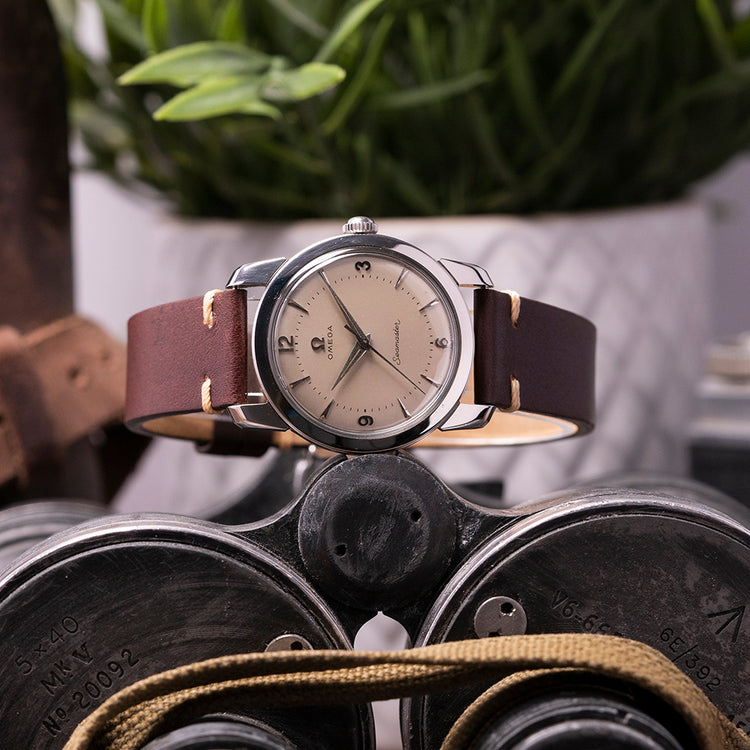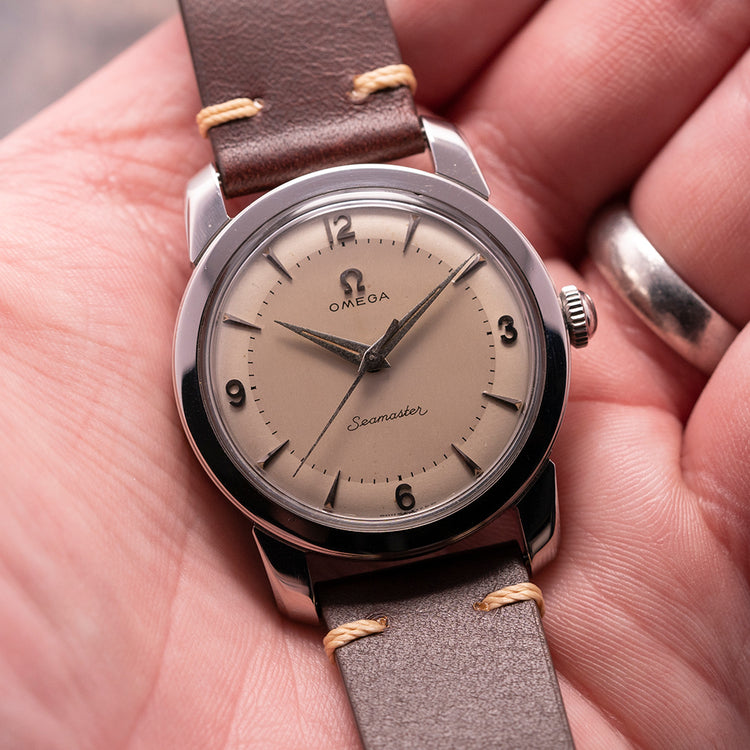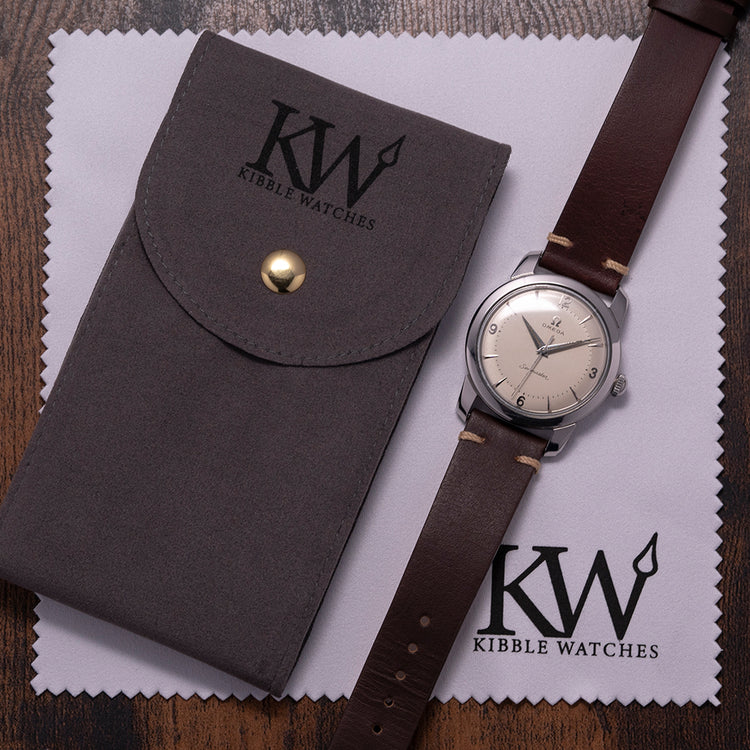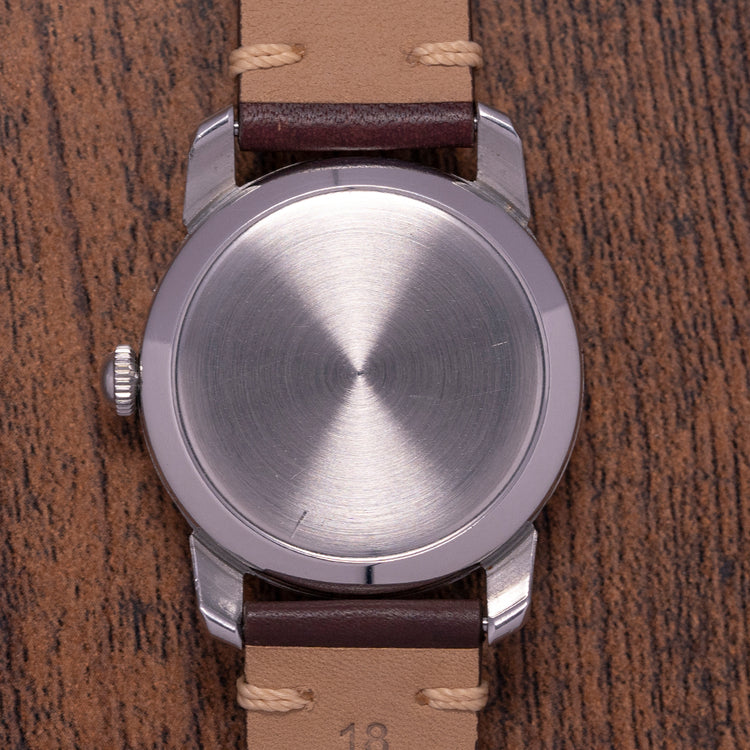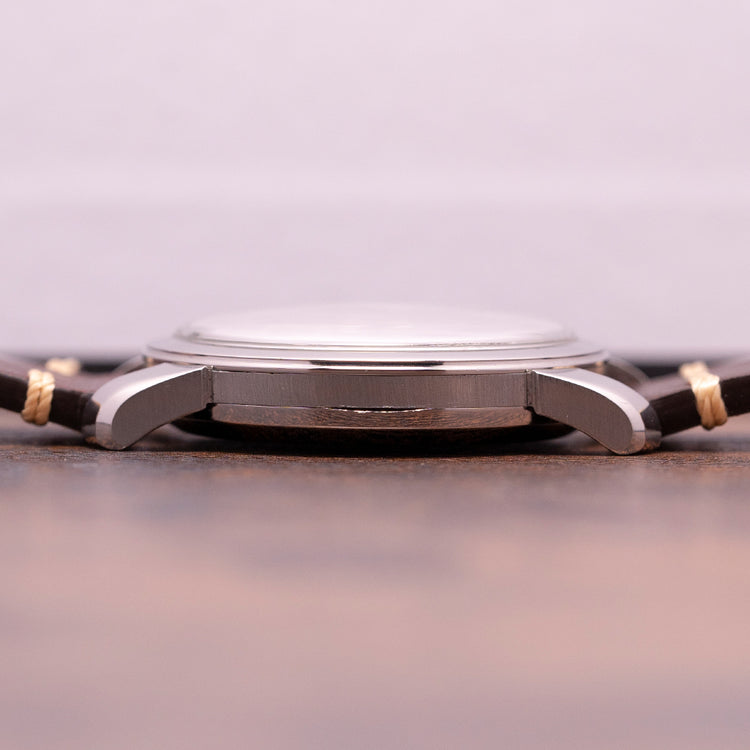More Information
Description
More
Less
The Watch
Here we have a stunning 1956 Omega Seamaster Manual Cal. 420 Dennison 803 with a 34mm stainless steel case made by Dennison, A.L.Dennison moved to Birmingham around 1871, where he produced high-quality watch cases, in no time Omega took notice and decided to commission ALD, some of Omega’s finest cases are made by Dennison. Tapering fat lugs provide a comfortable fit on the wrist, and polished and brushed surfaces transition with crisp lines throughout with a stepped polished bezel. A domed Omega signed crystal protects the magnificent champagne sector-style dial, applied polished arrow-pointed indexes with Arabic numerals at 12, 3, 6 and 9 mark the hours. Elegant Dauphine hands with a centre seconds hand that sweeps around the dial, the text is kept to a minimum with the Omega motif at 12 o’clock and Seamaster at 6 o’clock. On the back, we have an engine-turned case back, and inside the case back, we have a stamped “PAT Applied For” (could be referring to their O’Ring gasket Technology), “DeniSteel” stainless steel, DeniSteel was a trading name registered in 1934 by the English case maker Dennison; its own type of Staybrite, Staybrite Steel had been introduced to the Swiss watch industry in the 1920s by Firth Steel Sales AG, founded in 1919 in Switzerland as a subsidiary of Firth Brown, we most commonly find the DeniSteel stamp inside case backs from the 1940s to the 1960s on UK market models by Omega, Rolex, and IWC. While an excellent case manufacturer, Dennison most likely didn’t blend its steel, and it most likely would have been supplied by Brown Firth or one of its competitors. Inside a Manually Wound Omega Cal. 420, 17 jewels, beating at 18,000 beats per hour. The watch comes fitted on a well-suited 18mm brown vintage-style strap.
Points of Mention
This watch is sold as "Watch Only" and therefore comes with no original Omega box or paperwork. The watch comes paired with a well-suited brown vintage-style strap. The watch is from Circa. 1956 and is sold in fantastic worn vintage condition as you can see from the photographs, original Omega signed crystal, all original. The watch comes with our 12-Months Non-Waterproof Warranty.
For more photos see here - https://drive.google.com/drive/folders/1nChojJsyyGUohn1WMvCBI6bDyfJMPTJe?usp=share_link
Personal Note
There is no denying how I adore a vintage Seamaster and this Dennison case example is truly beautiful. The bold lugs of this case mean it wears incredibly well for 34mm and has a surprising wrist presence, pair that with the perfect original dial and beautiful handset, you've got yourself a winner! This is definitely one to try on to see for yourself!
Specification
Lugs : 18mm
Condition : Pre-Owned
Box & Papers : None
Case Material : Stainless Steel
Warranty : 12-Months NON-Waterproof
The Brand
Formerly known as the La Generale Watch Co. in 1848 founded by Louis Brandt in La Chaux-de-Fonds. When he died in 1879, his sons carried on his dream. In 1880 they moved to 96 Rue Jakob-Stampfli where they remain today. The brothers produced their first mass-produced calibre, the Labrador In 1885. Just a few years later in 1892, they produced the first minute-repeater. In 1903 they renamed the company Omega until 1982 when they officially changed their name to Omega SA. During WW1 Omega watches were used as official timekeepers for the Royal Flying Corps and the US Army. In 1930, Omega and Tissot merged together to form Société Suisse pour l'Industrie Horlogère (SSIH) In 1931, another group was formed - Allgemeine Schweizerische Uhrenindustrie AG (ASUAG). Where SSIH was primarily French-speaking, ASUAG was founded by the more German-speaking members of the Swiss watch industry. In 1948 they introduced the first edition of one of its most symbolic watches: the Seamaster. Omega first introduced the Constellation in 1952. At the time it was Omega's flagship timepiece. The first models had a Cal. 354 bumper movement in them. Later in 1955, Omega introduced the Automatic Cal. 50x, followed in 1959 by the Cal.55x (no date) and 56x (date) versions. Many of the Constellations came with pie-pan dials, diamond indexes, and fancy lug configurations. All the gold Constellations of that time have the Observatory of Geneva's hand engraved on the back. The stainless steel and stainless steel/gold versions had a gold medallion on the back with the Observatory of Geneva. The eight stars above the Observatory stand for the many exploits of Omega in the world Chronometer competition. Celebrating the fact that all Constellations are Chronometer Certified. In 1962, when astronaut Wally Schirra wore a Speedmaster on his Mercury Sigma 7 Mission, making it the first Omega watch to enter space. After rigorous tests, NASA used Omega for all their Apollo missions including the 1969 Moon landing of Apollo 11. Today Omega is still an astronaut's first choice. In 1969, President Nixon famously said it was “too valuable” and turned down the first-ever all-gold Speedmaster Professional Deluxe. As a response to the ever-growing threat of electronic watches to the manufacturers of mechanical watches, Omega and many Swiss brands such as Rolex and Patek Philippe formed Centre Electronique Horloger (CEH). Prototypes began to appear in 1967 with their production starting in 1968. Then In 1972, Omega introduced the reference, 198.030, which included the Omega calibre 1250, a ‘tuning-fork electronic movement which was made under licence from Bulova. Later we saw a merger of SSIH and ASUAG into SMH, or Société de Microélectronique et d’Horlogerie. This merger took place in 1983. In 1992, the company acquired Blancpain, and in 1998 it officially rebranded itself from SMH to the Swatch Group. Then, in 1999, they purchased and integrated Breguet into the Swatch Group.
Points of Mention
More
Less
Personal Note
More
Less
Specification
More
Less
Movement : Manually Wound Omega Cal. 420
Year : 1956
Case Size : 34mm
Case Thickness : 9.5 mm
Lug to Lug : 41.5mm
Lugs : 18mm
Condition : Pre-Owned
Box and Papers : None
Case Material : Stainless Steel
Warranty : 12-Months NON-Waterproof
The wrist model's wrist size is 7inch
About Omega
More
Less
Description
The Watch
Here we have a stunning 1956 Omega Seamaster Manual Cal. 420 Dennison 803 with a 34mm stainless steel case made by Dennison, A.L.Dennison moved to Birmingham around 1871, where he produced high-quality watch cases, in no time Omega took notice and decided to commission ALD, some of Omega’s finest cases are made by Dennison. Tapering fat lugs provide a comfortable fit on the wrist, and polished and brushed surfaces transition with crisp lines throughout with a stepped polished bezel. A domed Omega signed crystal protects the magnificent champagne sector-style dial, applied polished arrow-pointed indexes with Arabic numerals at 12, 3, 6 and 9 mark the hours. Elegant Dauphine hands with a centre seconds hand that sweeps around the dial, the text is kept to a minimum with the Omega motif at 12 o’clock and Seamaster at 6 o’clock. On the back, we have an engine-turned case back, and inside the case back, we have a stamped “PAT Applied For” (could be referring to their O’Ring gasket Technology), “DeniSteel” stainless steel, DeniSteel was a trading name registered in 1934 by the English case maker Dennison; its own type of Staybrite, Staybrite Steel had been introduced to the Swiss watch industry in the 1920s by Firth Steel Sales AG, founded in 1919 in Switzerland as a subsidiary of Firth Brown, we most commonly find the DeniSteel stamp inside case backs from the 1940s to the 1960s on UK market models by Omega, Rolex, and IWC. While an excellent case manufacturer, Dennison most likely didn’t blend its steel, and it most likely would have been supplied by Brown Firth or one of its competitors. Inside a Manually Wound Omega Cal. 420, 17 jewels, beating at 18,000 beats per hour. The watch comes fitted on a well-suited 18mm brown vintage-style strap.
Points of Mention
This watch is sold as "Watch Only" and therefore comes with no original Omega box or paperwork. The watch comes paired with a well-suited brown vintage-style strap. The watch is from Circa. 1956 and is sold in fantastic worn vintage condition as you can see from the photographs, original Omega signed crystal, all original. The watch comes with our 12-Months Non-Waterproof Warranty.
For more photos see here - https://drive.google.com/drive/folders/1nChojJsyyGUohn1WMvCBI6bDyfJMPTJe?usp=share_link
Personal Note
There is no denying how I adore a vintage Seamaster and this Dennison case example is truly beautiful. The bold lugs of this case mean it wears incredibly well for 34mm and has a surprising wrist presence, pair that with the perfect original dial and beautiful handset, you've got yourself a winner! This is definitely one to try on to see for yourself!
Specification
Lugs : 18mm
Condition : Pre-Owned
Box & Papers : None
Case Material : Stainless Steel
Warranty : 12-Months NON-Waterproof
The Brand
Formerly known as the La Generale Watch Co. in 1848 founded by Louis Brandt in La Chaux-de-Fonds. When he died in 1879, his sons carried on his dream. In 1880 they moved to 96 Rue Jakob-Stampfli where they remain today. The brothers produced their first mass-produced calibre, the Labrador In 1885. Just a few years later in 1892, they produced the first minute-repeater. In 1903 they renamed the company Omega until 1982 when they officially changed their name to Omega SA. During WW1 Omega watches were used as official timekeepers for the Royal Flying Corps and the US Army. In 1930, Omega and Tissot merged together to form Société Suisse pour l'Industrie Horlogère (SSIH) In 1931, another group was formed - Allgemeine Schweizerische Uhrenindustrie AG (ASUAG). Where SSIH was primarily French-speaking, ASUAG was founded by the more German-speaking members of the Swiss watch industry. In 1948 they introduced the first edition of one of its most symbolic watches: the Seamaster. Omega first introduced the Constellation in 1952. At the time it was Omega's flagship timepiece. The first models had a Cal. 354 bumper movement in them. Later in 1955, Omega introduced the Automatic Cal. 50x, followed in 1959 by the Cal.55x (no date) and 56x (date) versions. Many of the Constellations came with pie-pan dials, diamond indexes, and fancy lug configurations. All the gold Constellations of that time have the Observatory of Geneva's hand engraved on the back. The stainless steel and stainless steel/gold versions had a gold medallion on the back with the Observatory of Geneva. The eight stars above the Observatory stand for the many exploits of Omega in the world Chronometer competition. Celebrating the fact that all Constellations are Chronometer Certified. In 1962, when astronaut Wally Schirra wore a Speedmaster on his Mercury Sigma 7 Mission, making it the first Omega watch to enter space. After rigorous tests, NASA used Omega for all their Apollo missions including the 1969 Moon landing of Apollo 11. Today Omega is still an astronaut's first choice. In 1969, President Nixon famously said it was “too valuable” and turned down the first-ever all-gold Speedmaster Professional Deluxe. As a response to the ever-growing threat of electronic watches to the manufacturers of mechanical watches, Omega and many Swiss brands such as Rolex and Patek Philippe formed Centre Electronique Horloger (CEH). Prototypes began to appear in 1967 with their production starting in 1968. Then In 1972, Omega introduced the reference, 198.030, which included the Omega calibre 1250, a ‘tuning-fork electronic movement which was made under licence from Bulova. Later we saw a merger of SSIH and ASUAG into SMH, or Société de Microélectronique et d’Horlogerie. This merger took place in 1983. In 1992, the company acquired Blancpain, and in 1998 it officially rebranded itself from SMH to the Swatch Group. Then, in 1999, they purchased and integrated Breguet into the Swatch Group.
Points of Mention
Personal Note
Specification
The Brand
Enquire or Book an Appointment
Would you like to discover further details about this watch, or perhaps arrange an appointment to view and try it on? Complete this form and a member of our team will get back to you shortly.
You May Also Like




















